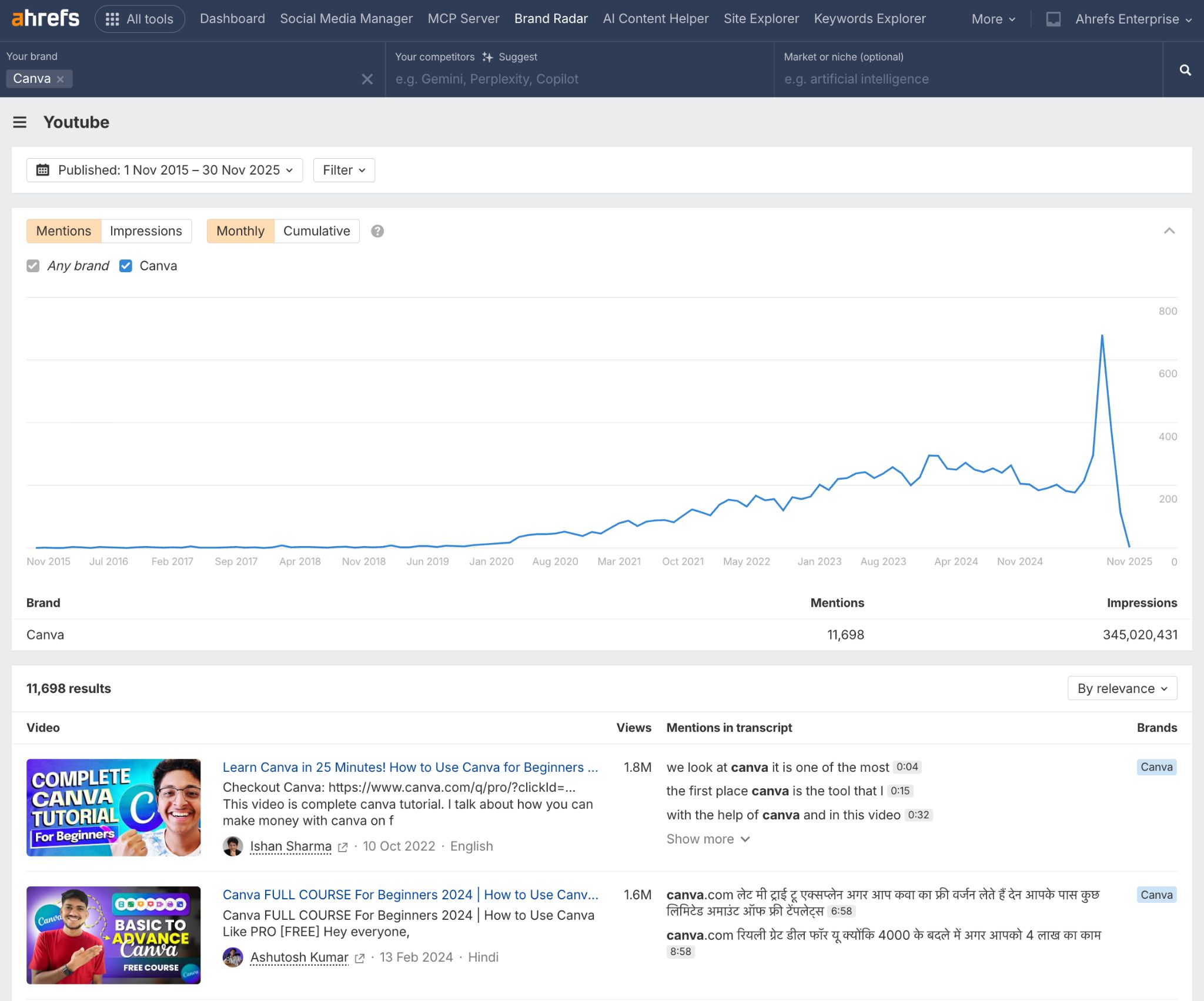YouTube is the second-largest search engine, where users spend roughly 50 minutes daily (and growing).
It’s also the 2nd most cited source by LLMs, meaning video mentions don’t just reach human audiences—they teach AI how to recommend your brand.
YouTube creators are shaping brand narratives in front of millions of viewers.
Take Canva: it picked up around 460 YouTube mentions this month (according to the YouTube report in Ahrefs Brand Radar).
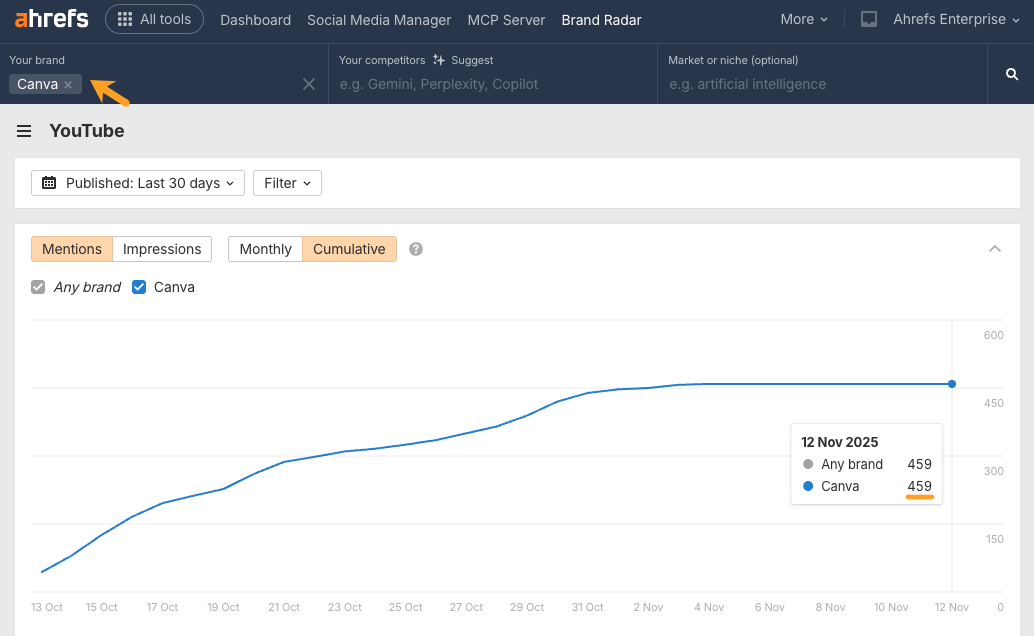
That might not sound like much, until you realize those 460 mentions translate to 3.4 million views.
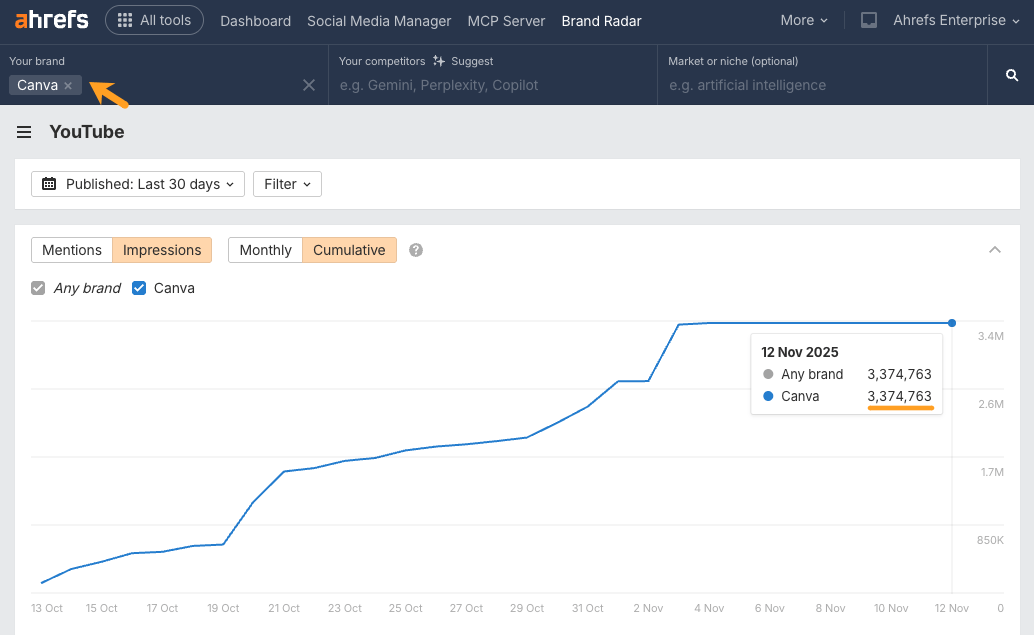
If you’re not monitoring your YouTube mentions, you’re leaving your reputation in someone else’s hands.
YouTube mentions are any instance where your brand name appears in a channel name, title, description, transcript, or link.
There are two distinct types:
Tagged mentions
Tagged mentions work like social media tags (e.g. @channelname). They link to your channel, and trigger notifications in YouTube whenever you’re mentioned in titles, descriptions, or comments.
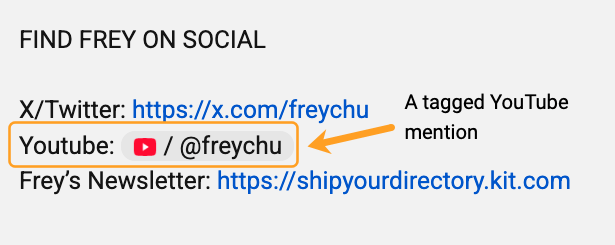
One thing to remember about tagged mentions is that the creator has to intentionally tag you—they aren’t just casual passing mentions.
Untagged mentions
Untagged mentions, on the other hand, are organic mentions. They don’t link back to your channel and you won’t get notified when you land one. Untagged mentions can appear anywhere: in channel names, thumbnails, titles, descriptions, transcripts, and links.
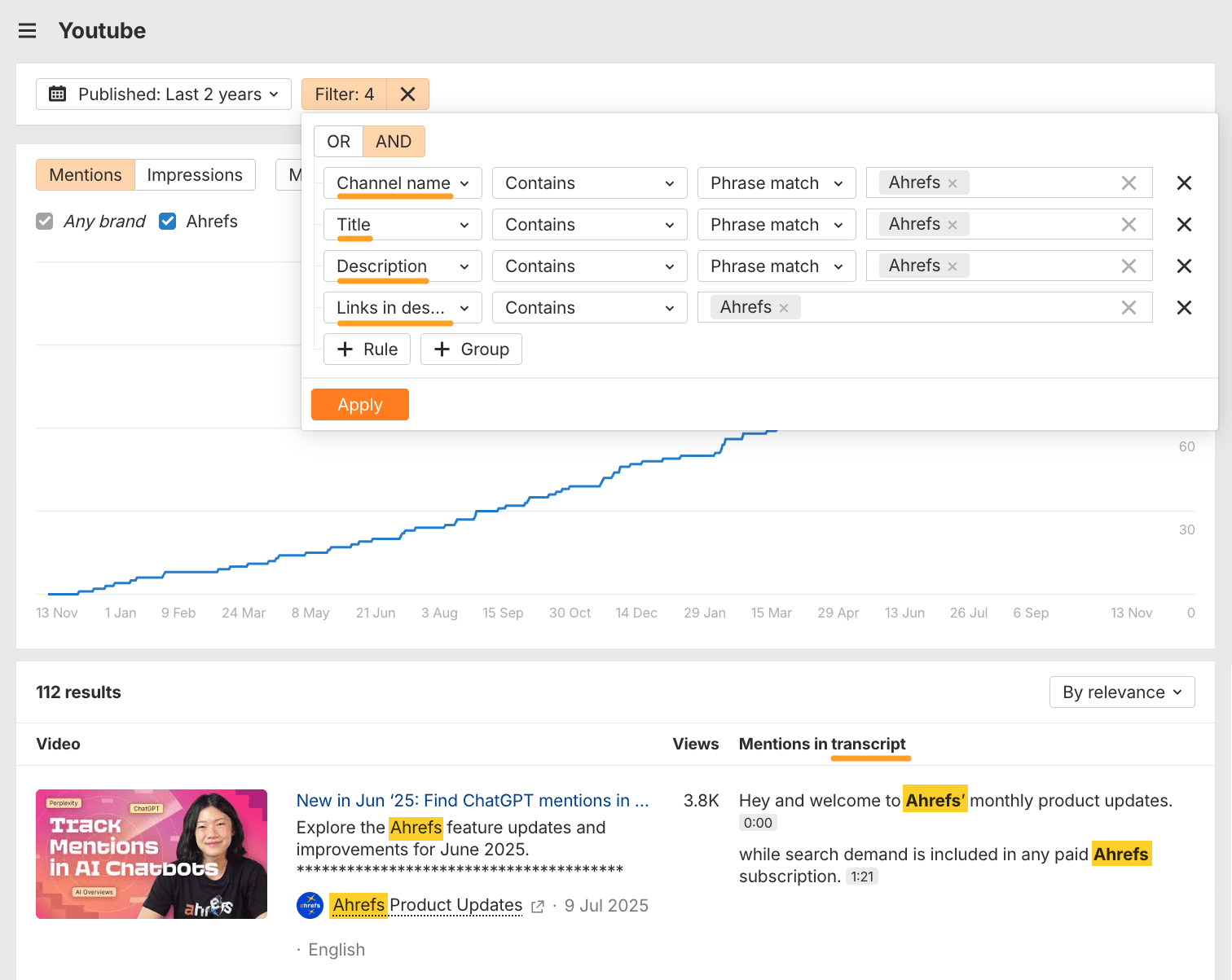
YouTube mentions can take the form of:
- References to your product/service even without using the exact brand name
- Comparisons or reviews that feature your brand alongside others
- Casual name-drops in tutorials, vlogs, or commentary content
You can monitor mentions in tagged posts natively within YouTube Studio.
Just head to “Community” in the menu on the left, and look for the “Mentions” tab on the dashboard.
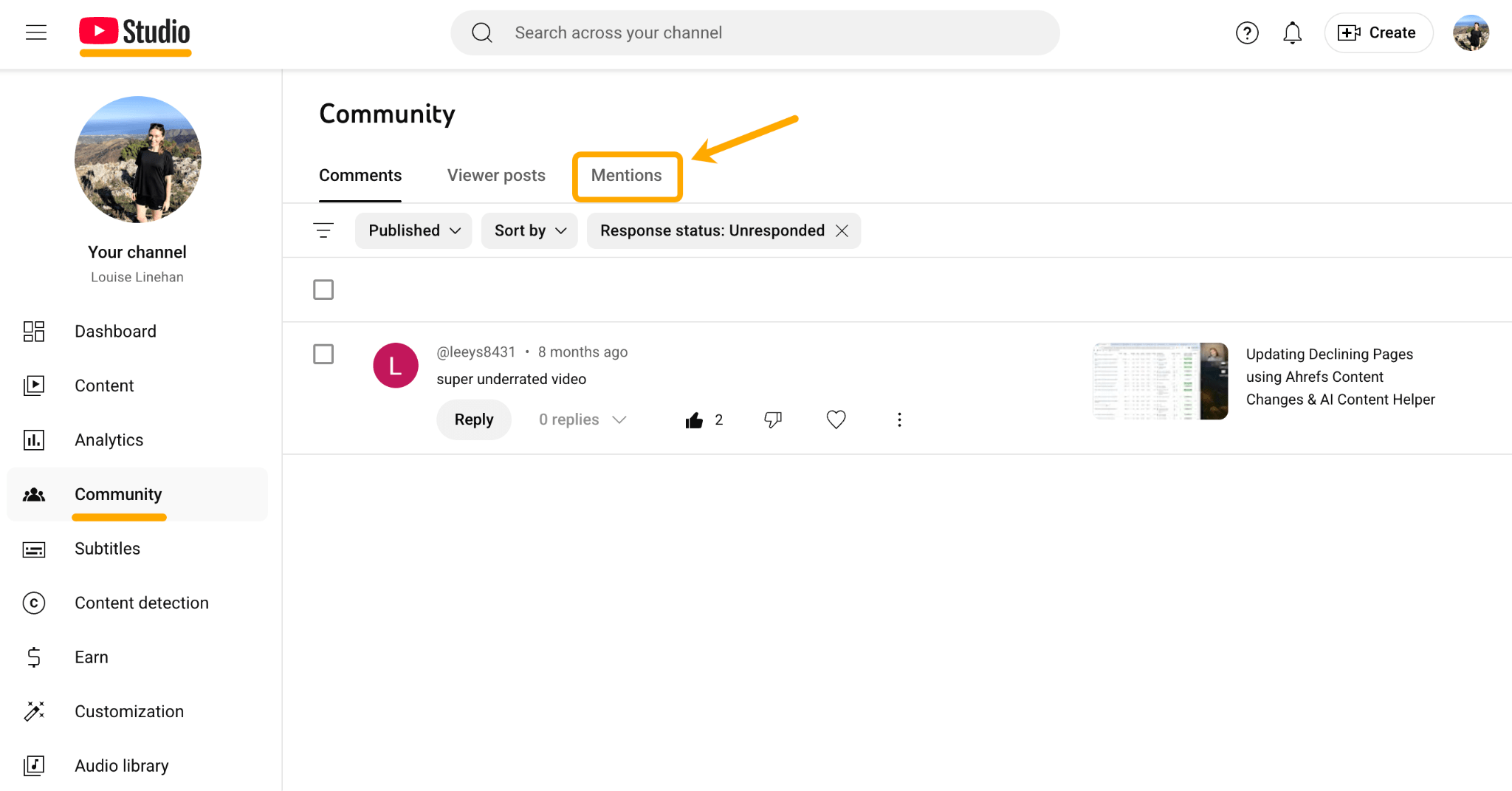
But for untagged mentions, you’ll need a social media monitoring tool.
Brand Radar’s YouTube monitoring tool does exactly this—tracking your brand across ~15M videos (and growing) by scanning titles, descriptions, and transcripts.

In this guide, I’ll walk you through monitoring YouTube mentions with this tool, using real examples from Ahrefs.
YouTube mentions are a leading indicator of brand health.
When more creators talk about you organically, it signals awareness is growing around your brand.
Often that translates as increased search volume, AI citations and, ultimately, business growth.
If you monitor your mentions every month, you can see if awareness is growing or declining, find out what’s driving spikes in conversation, and prove the ROI of your brand-building with concrete data.
And there are tons more use cases and benefits…
- Measure brand buzz: Track mention volume month-over-month to see if awareness is accelerating or stalling. For example, if mentions doubled after your rebrand, you know it’s working
- Assess campaign impact: Compare mention spikes to campaign launch dates to prove which initiatives actually moved the needle—if mentions jumped 3x during your product launch week, that’s your proof of impact
- Benchmark against goals: Set quarterly mention targets (e.g. 500 mentions in Q1) to hold your team accountable and guide budget decisions
- Justify investment: Show stakeholders concrete evidence of growing brand presence (e.g. 150% YoY growth in impressions), to secure next year’s budget
- Identify breakout moments: Pinpoint what caused sudden mention spikes (e.g. product launches, viral videos, PR hits) to replicate that success again and again
- Forecast future visibility: Watch for sustained YouTube mention growth as an early indicator of rising search rankings and AI citations
How to monitor your YouTube mentions consistently
Add your brand name and variants to Brand Radar’s YouTube monitoring tool, then use the report view to track your total YouTube mentions month-over-month.
Start off by dropping your brand name—plus any pronunciation variations—into the “Your brand” field.
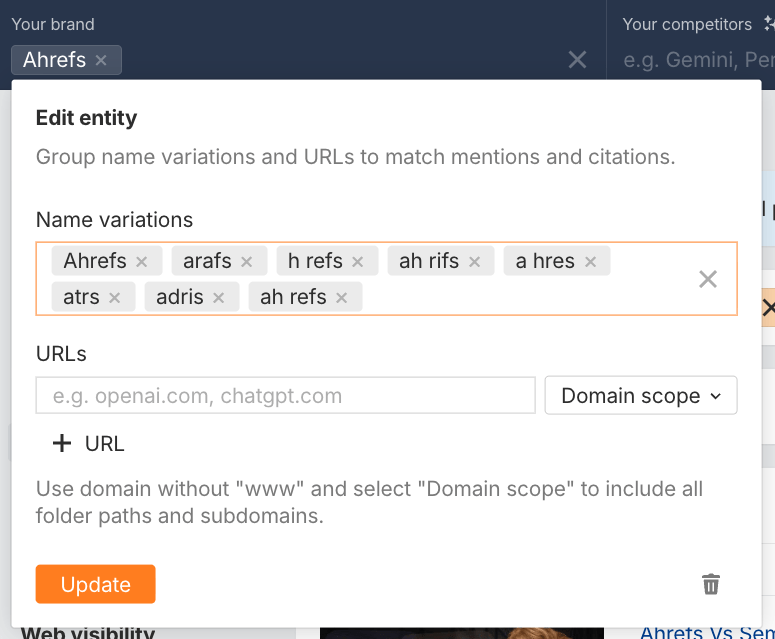
If your brand name is also tricky to pronounce, think about tracking for mentions of your brand’s features, products, or services.
For example, “Keyword difficulty” and “Domain rating” are both uniquely developed Ahrefs scores, so we might want to think about tracking those to get a better sense of where our brand is referenced.
You can save these variations by hitting the “Save report” button on the main Brand Radar dashboard:
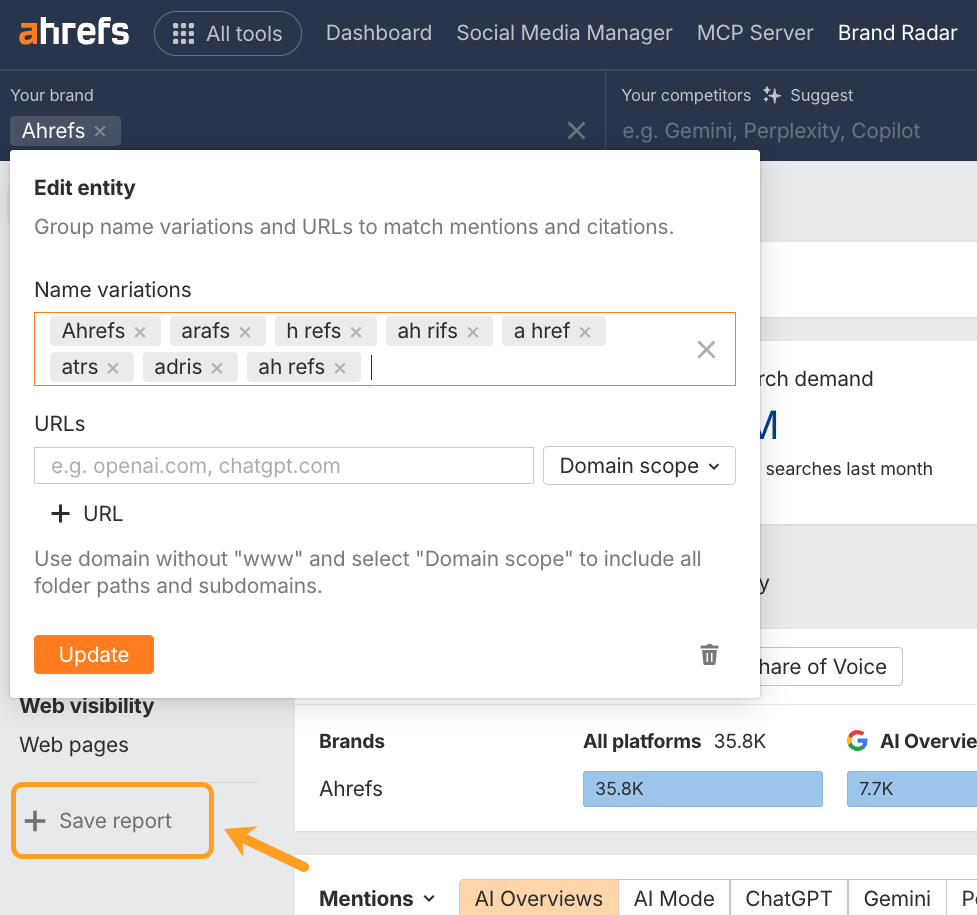
In return, you’ll get a monthly view of your YouTube brand mentions, which you can track periodically to assess growth or decline.
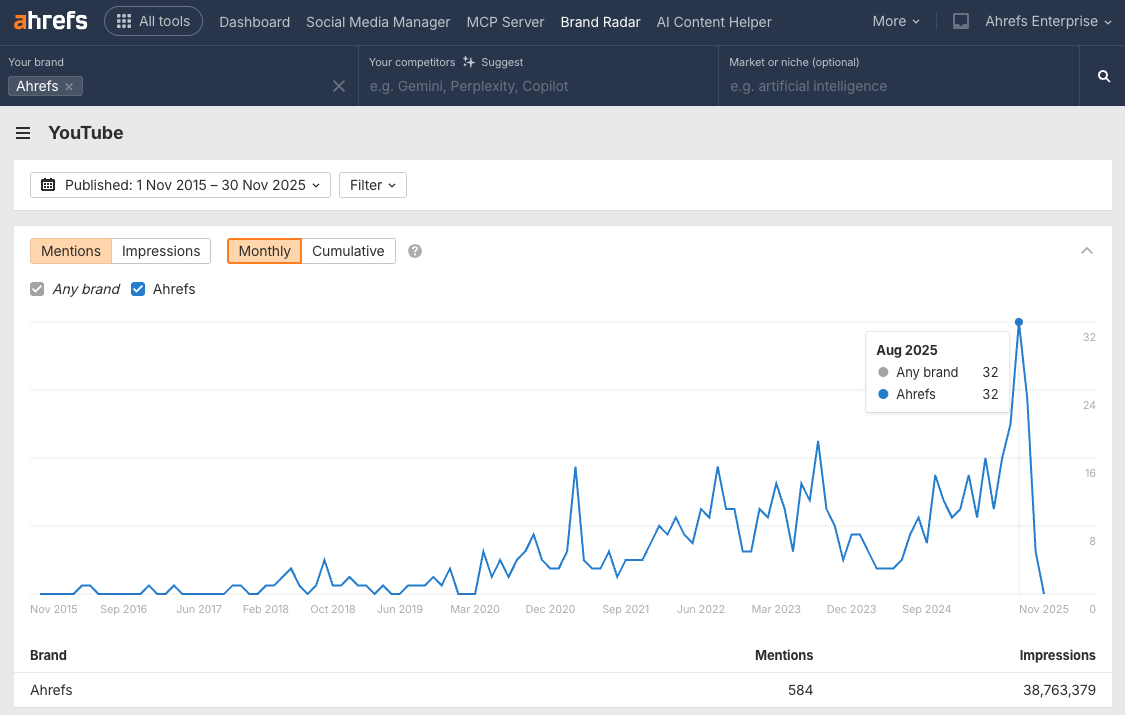
Beneath that, you’ll see a list of videos organically mentioning your brand, ordered by “relevance”.
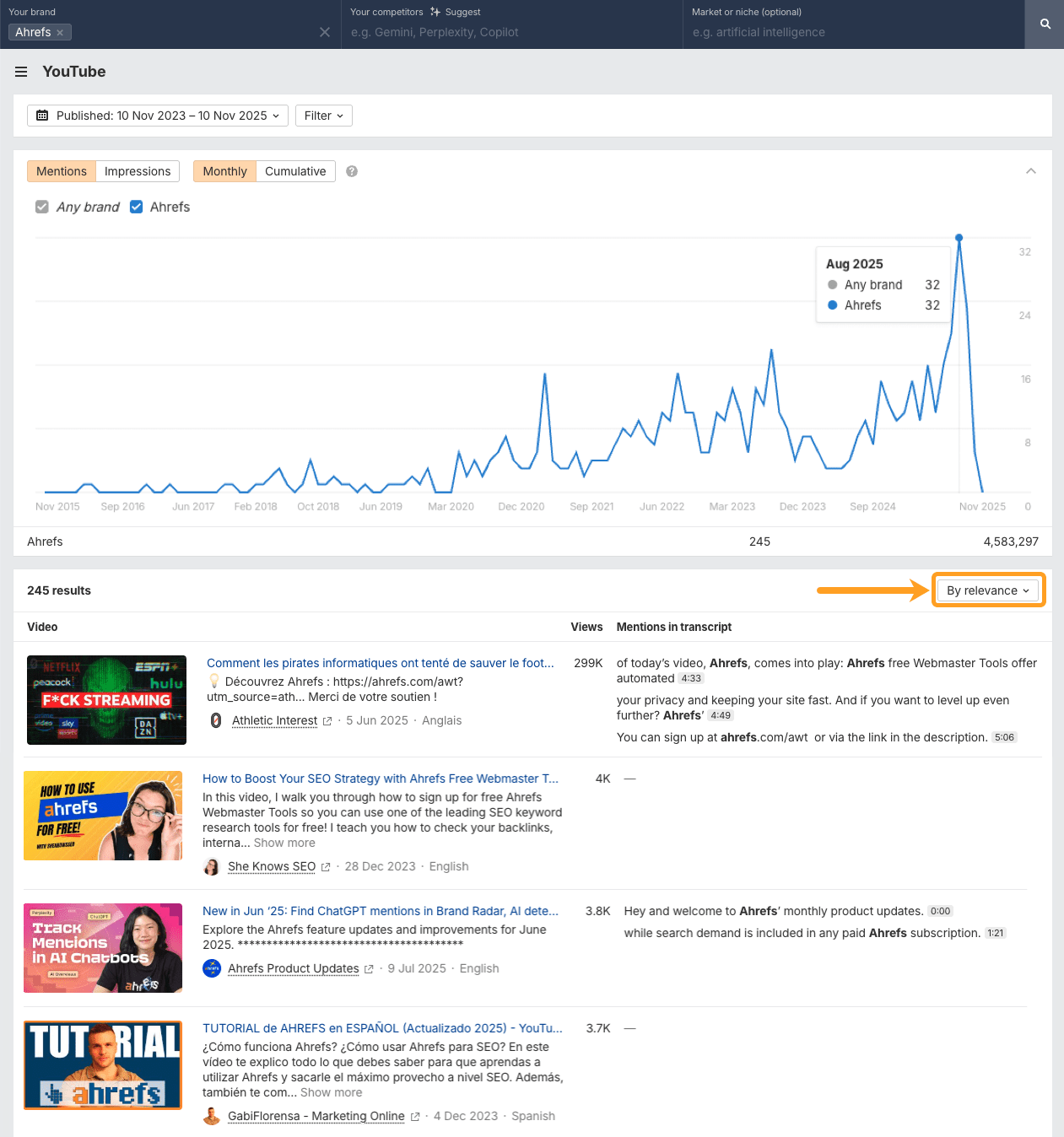
Results that are considered “relevant” are ranked based on a combination of mention frequency and view count.
Unprompted brand mentions tell you what’s working, how people naturally describe your brand, and which use cases resonate so much that creators can’t help but share them.
And, best of all, none of it costs you a cent.
When you monitor organic brand mentions, you can:
- Get unfiltered perception: Read organic mentions to catch honest opinions (e.g. “clunky UI” or “amazing support”), then address recurring criticisms in product updates (e.g. fix UI issues) and fold praise into your marketing (e.g. homepage copy)
- Market the right use cases: Discover new and novel ways audiences use your product, then build campaigns around them. For example, if creators use your project management tool for podcast production, create a landing page targeting that niche
- Shape messaging: Note the phrases audiences use, then adopt them in your web or ad copy. For instance, if reviewers call you “stupid simple,” swap out generic lines like “intuitive platform” for their exact language
- Spot content gaps: See which topics appear alongside your mentions, then create content for them. For example, if “SEO audits” comes up frequently, publish a how-to guide on that topic
How to do find organic video mentions
Finding organic mentions is not just a case of searching for your brand name. You need to filter out partners and competitors, if you want to see mentions that are truly organic.
Start by adding a “doesn't contain” filter, to rule out:
- Your owned channels (e.g. Ahrefs)
- Sponsored keywords in descriptions (e.g. #spon, #ad)
- Partner URL fragments (e.g. /partner/)
For example, below I’ve excluded our owned YouTube channels with a channel name > doesn’t contain> Ahrefs filter.
Then I’ve ruled out certain elements our partners typically include in their video descriptions, like partner links containing yt., or specific products that we’ve been working with them to promote like awt (i.e. Ahrefs Webmaster Tools).
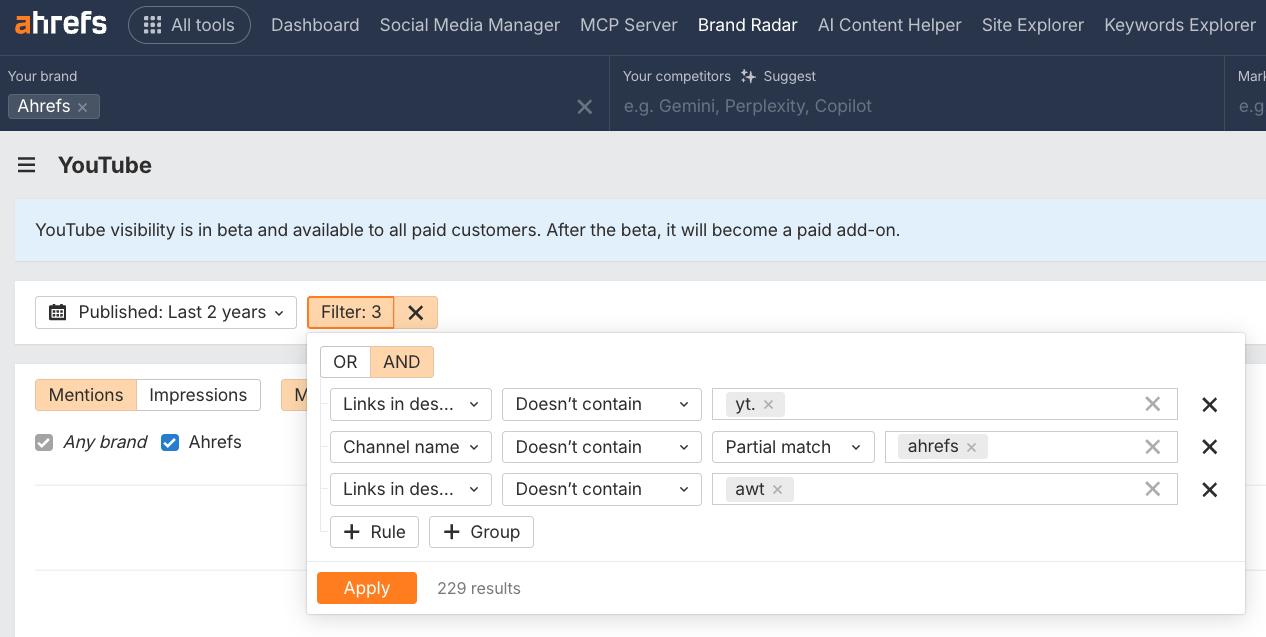
That filter takes us from 1,482 results to 229 word of mouth mentions. But we’re not done yet.
Some of these mentions are showcasing alternatives to Ahrefs, or pitting us against our competitors.
For now, we want to focus on UGC that is centered around our brand—not our competitors.
So, we need to add a Title > doesn’t contain > partial match > [competitor name]. This leaves us with 201 mentions.

If you’ve followed along so far, you can continue filtering even further to see which videos your brand is the primary focus of (e.g. Title > contains > partial match > [brand name])
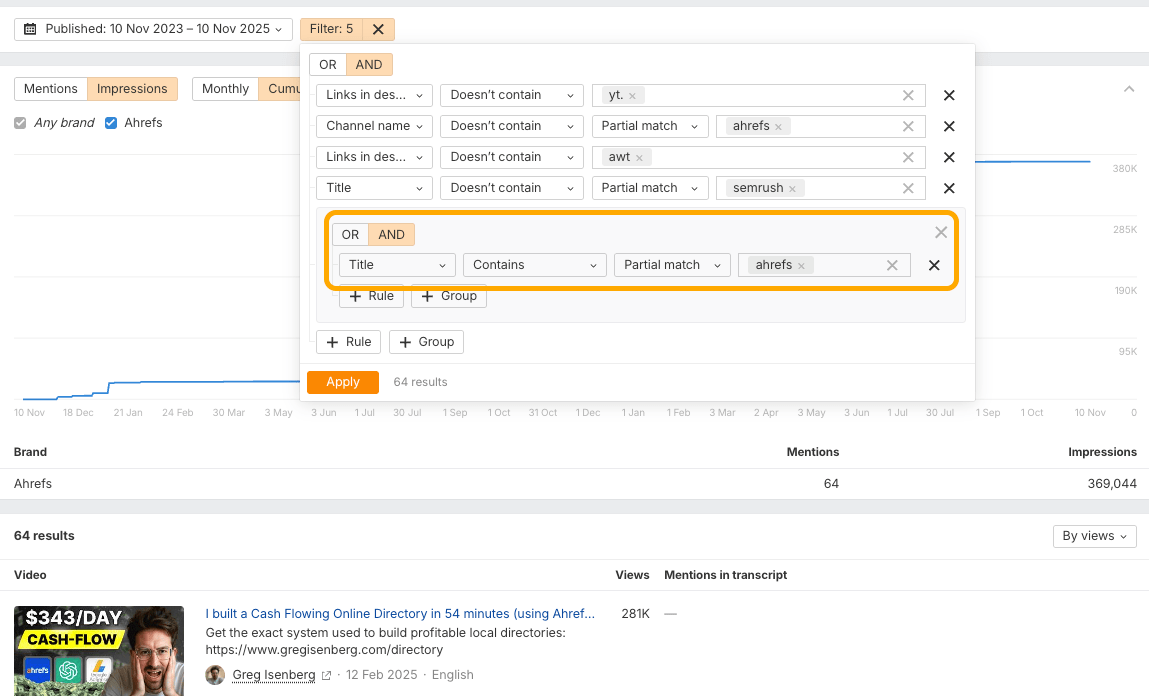
Versus the videos that mention it in passing (e.g. Title > Doesn’t contain > partial match > [brand name])
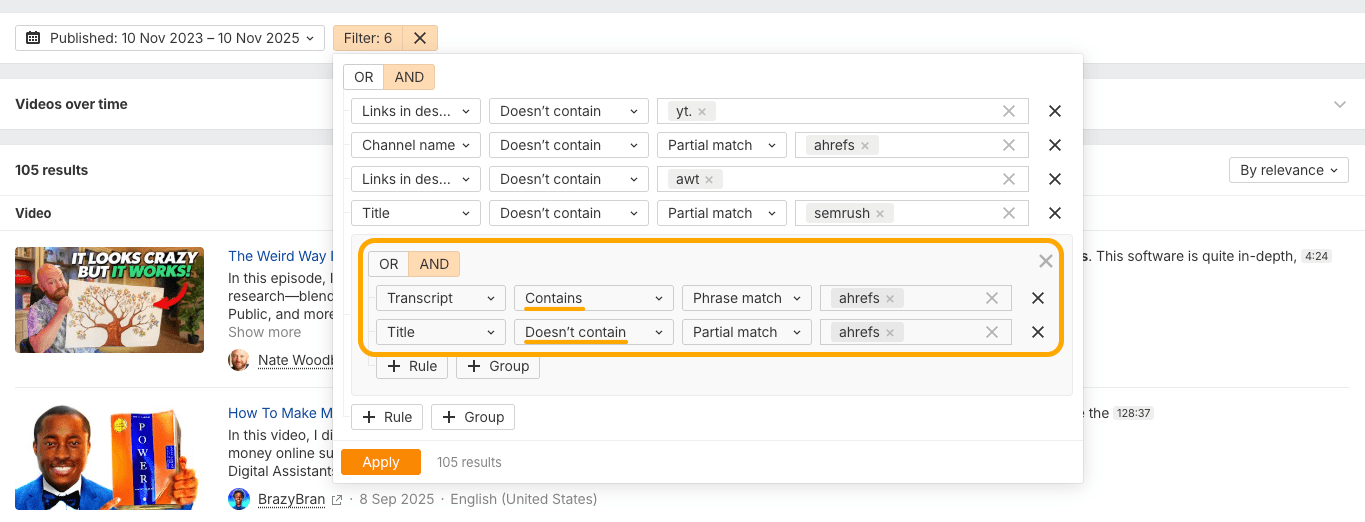
This kind of analysis can show you how customers actually use your products and services.
For example, the video below shows that people particularly use our tool Brand Radar for AI competitor gap analysis…
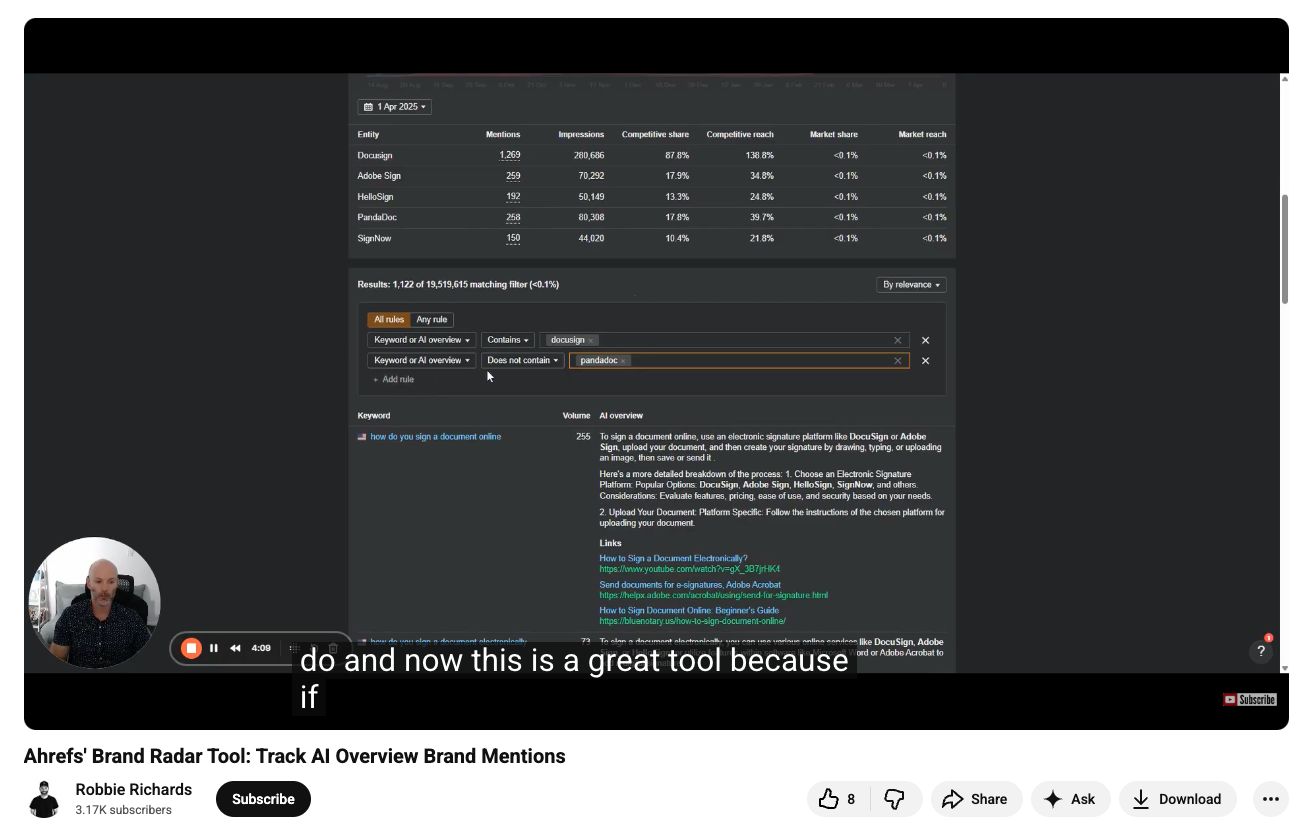
While the next video shows that some users would like to see more actionable recommendations within the platform…
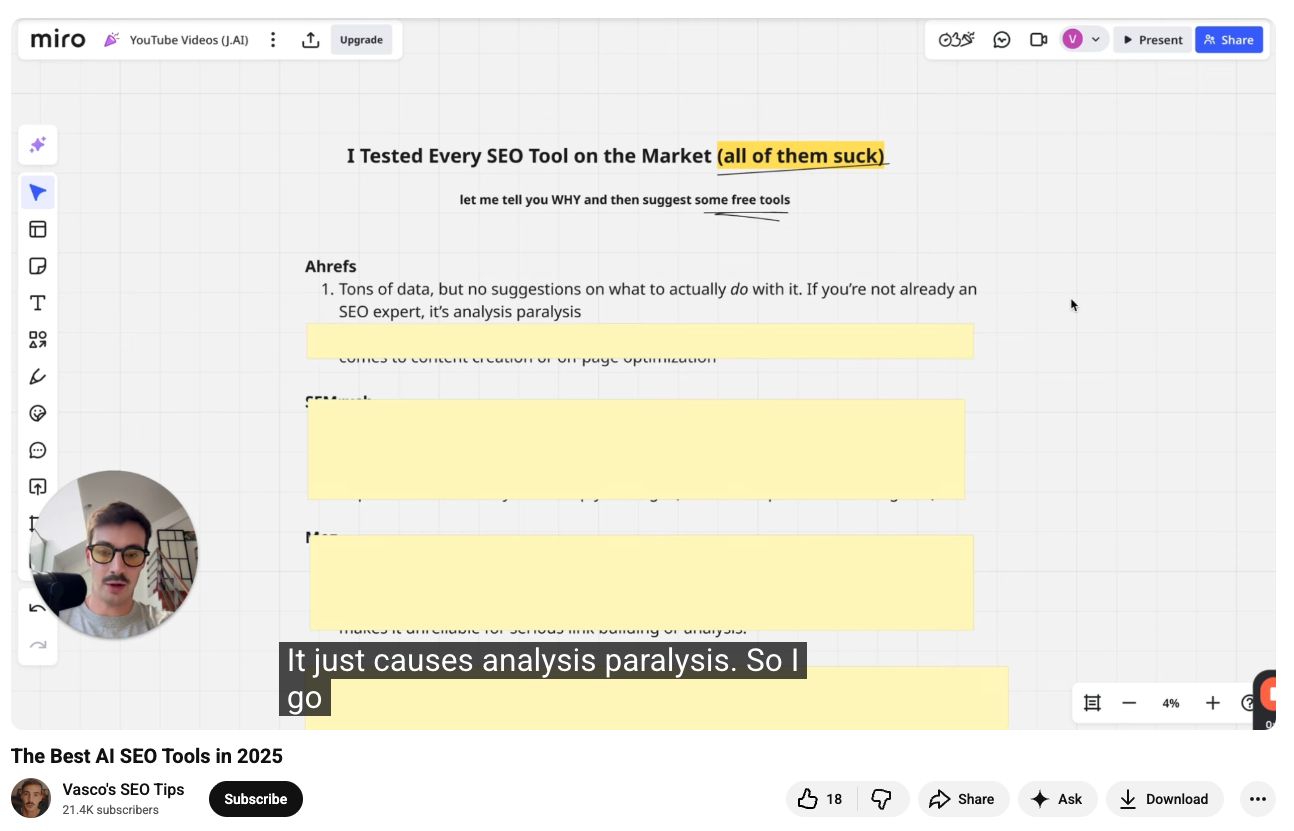
You can use these kinds of insights to shape your content, and pass them over to the product team to inform your roadmap.
Instead of cold-pitching influencers, start with creators that are already discussing your brand or topics in your space.
This will help you track down high-potential partners whose audiences and niche naturally align with your own.
There are a ton of benefits to monitoring influencer mentions:
- Find creator fans: Track down influencers already mentioning your brand organically, then send them early access to features or paid partnership offers they’re likely to accept
- Assess audience fit: Before reaching out, see if their viewers match your target market, so you only pitch to channels where your product actually resonates
- Prioritize high-impact creators: Sort by view counts and engagement, then allocate your sponsorship budget to the top performers
- Tailor your pitch: Pull specific quotes like “I love how [Brand] handles X,” then open your email with “Saw you praised our X feature in your recent video—interested in test-driving the upgrade?”
- Save time and budget: Build a shortlist of pre-vetted creators who actually align with your brand, instead of cold-pitching dozens and hoping something sticks
How to find relevant influencers to sponsor
Find creators worth partnering with by sorting organic mentions based on your goals, then zero in on videos and audiences that actually align with your brand.
Start with the report you’ve already configured to find organic word-of-mouth mentions (i.e. the one that filters out your brand channels and the partners you already sponsor).
The aim is to discover the most visible creators, with audiences that are relevant to your brand.
As I said earlier, your YouTube mentions are sorted by “relevance”—which is a combination of mention frequency and view count by default.
That means you should be able to find quality influencer mentions right off the bat.
But some great opportunities may be trickier to track down.
For instance, you might land just one mention in a highly visible video that ends up being hyper-relevant.
That’s why it’s important to test out different sorting options—e.g. order “By views” vs. “By relevance”.
Then, when you come across a creator that looks interesting, you can read the transcript and watch the video to better understand the context of your brand mention.
Here’s an example of what I mean.
I set the chart in Brand Radar’s YouTube report to Impressions, and found one mention that bumped up our brand awareness by 115% overnight.
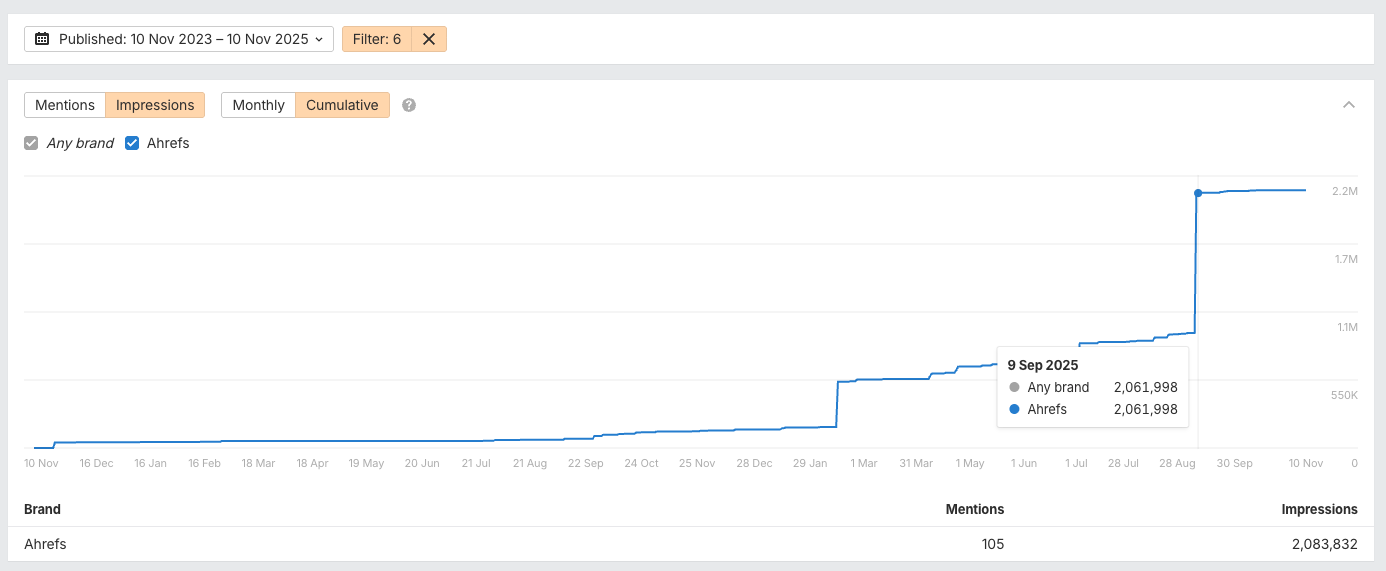
I tracked it down in the list view (by sorting “By views”), then clicked the transcript timecode to watch the video and understand the mention context.

Ultimately, the creator briefly recommended Ahrefs as a long-tail keyword tool for solopreneurs looking to start SEO-monetized blogs.
Understanding the context helps you get a better idea of whether an influencer is worth sponsoring. You can quickly assess:
- Is this an audience you want to reach?
- Is the recommended product/service valuable to your business?
- Does the channel or video topic align with your marketing goals?
In this example, the audience probably isn’t right for Ahrefs. The video primarily targets beginners who are more likely to be interested in our free keyword tools.
Our priority, on the other hand, is promoting our more advanced tools to mature SEOs and marketers in medium-sized to enterprise businesses.
Which brings me on to the next video…

While it has fewer views, it features Ahrefs in workflows that appeal to our actual target audience: mature marketers in corporate brands.
It also covers a topic that is a big product focus for us right now: AI.
Plus the creator shows off a use case that could be even better handled by our new ChatGPT SEO tool: Ahrefs MCP.
Diving even deeper, I can see the creator has ~98K subscribers, and that her channel aligns with our topic focus: Digital marketing, AI strategy, professional growth, tech & business.
So that’s an:
- Audience match
- Product match
- Marketing/topic match
To me, this looks like a much better partnership opportunity.
If you want to cast an even wider net, you can repeat this whole process, but remove your own brand mentions from the equation, and instead filter by the market/industry you’re aiming to get mentioned in.
For example, here’s a detailed filter I built to find relevant creators in the “AI marketing space”.
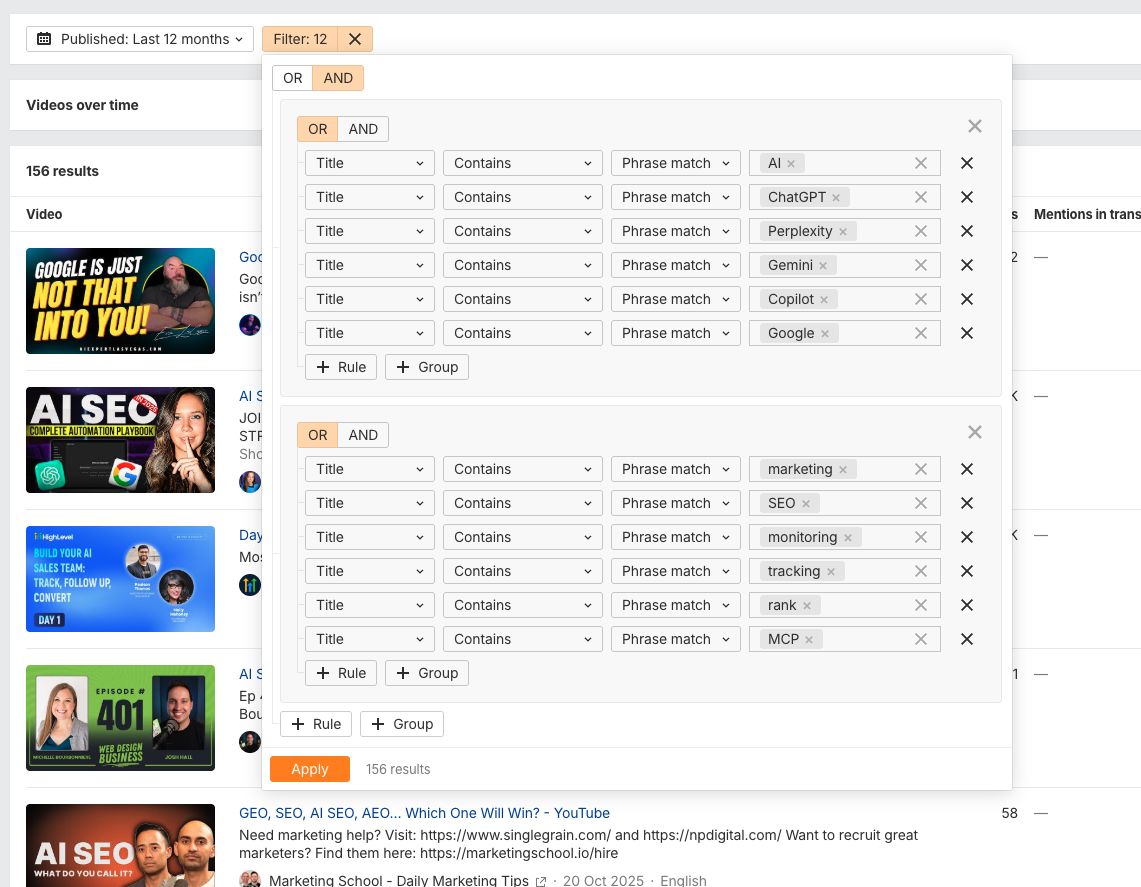
Use the filters to sort through your mentions until you find creators worth partnering with.
Before people open their wallets, they’re on YouTube watching reviews and checking if your product or service actually solves their problem.¹
These mentions reveal what draws buyers to your brand, or sends them to a competitor.
Tracking bottom-of-funnel YouTube mentions helps you:
- Address common objections: Spot recurring concerns in reviews, then publish blog posts, update your FAQ page, or ship product fixes that directly counter them
- Double down on differentiators: When creators say one of your features beats your competitors, spotlight it on your homepage, product pages, paid ads, and sales decks
- Train your sales team: Give sales reps responses to the exact objections, questions, and problems appearing in these videos
- Mine testimonials: Find authentic customer stories in video mentions, then screenshot quotes for your website, repurpose clips for social proof ads, or build case studies around them
- Sponsor strategic comparisons: Find creators who position you favorably against competitors, then reach out with sponsorship offers or new talking points to reinforce
- Correct misinformation: Catch inaccurate comparisons in videos, email the creator with accurate info, or offer to collaborate on an updated video
- Improve feature priorities: See which competitor features consistently win over buyers, then bump similar capabilities up your product roadmap or sunset features nobody mentions
- Optimize comparison pages: Note what buyers actually care about in video comparisons, then rewrite your “Brand vs Competitor” landing pages to lead with those exact pain points and features
How to find high purchase intent mentions on YouTube
The easiest way to find mentions of your brand in buyer-focused content is to search for comparison videos featuring your brand and competitors.
Keep your earlier “doesn’t contain” filters active (i.e. the ones excluding your own brand channel and partners), then reintroduce the competitors that you filtered out.
In this example, I’ve simply removed the Title > doesn’t contain > partial match > [competitor name] filter.
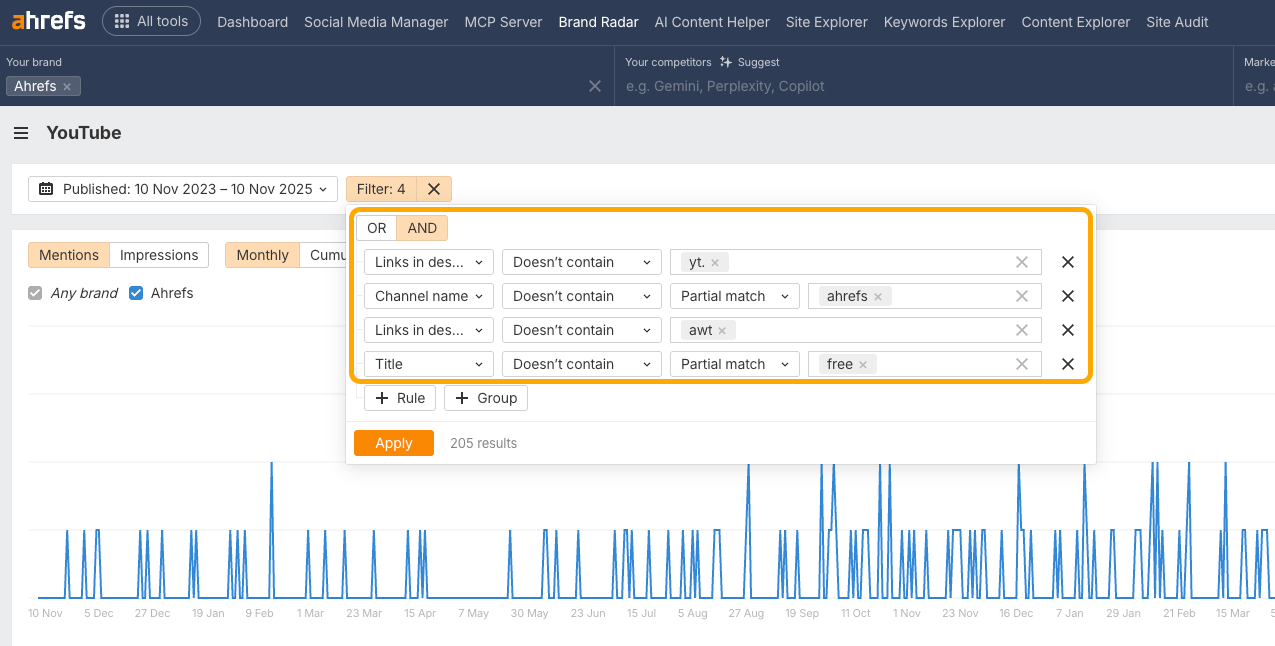
I’ve also excluded mentions of the word “free” in the video title, just so I can focus on creators reviewing our paid tools.
Now all of our competitors are back in the game.
If you have a larger brand with more mentions, you can add extra keyword modifiers to zero in on comparison content—e.g.
- versus/vs
- alternative
- compares/compared/comparison
- review
- pros and cons
- worth it
- best
- top
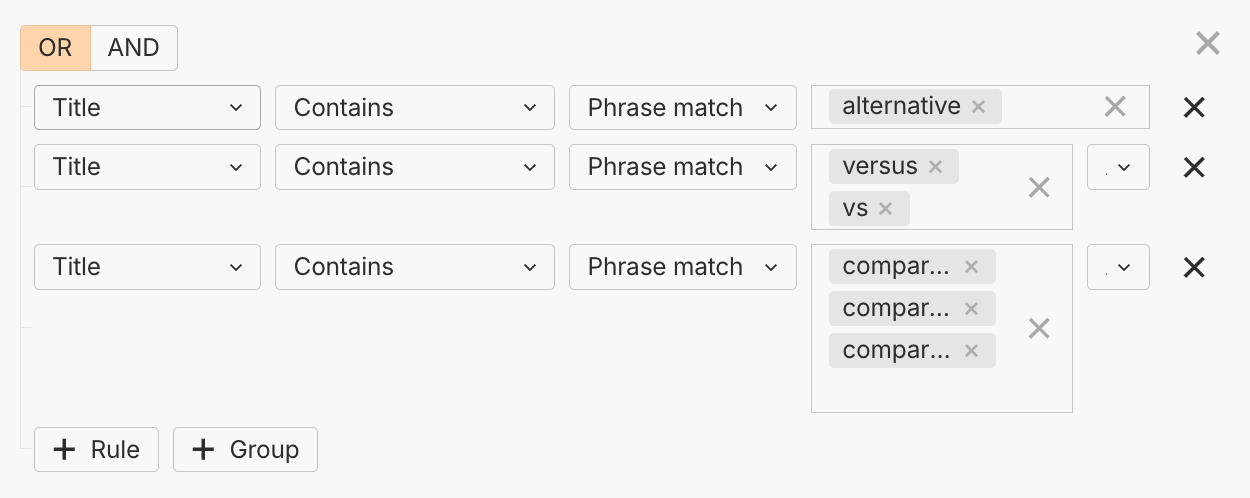
This wasn’t necessary for us, as our most popular mentions tend to come from head-to-head reviews, so they’re pretty easy to find.
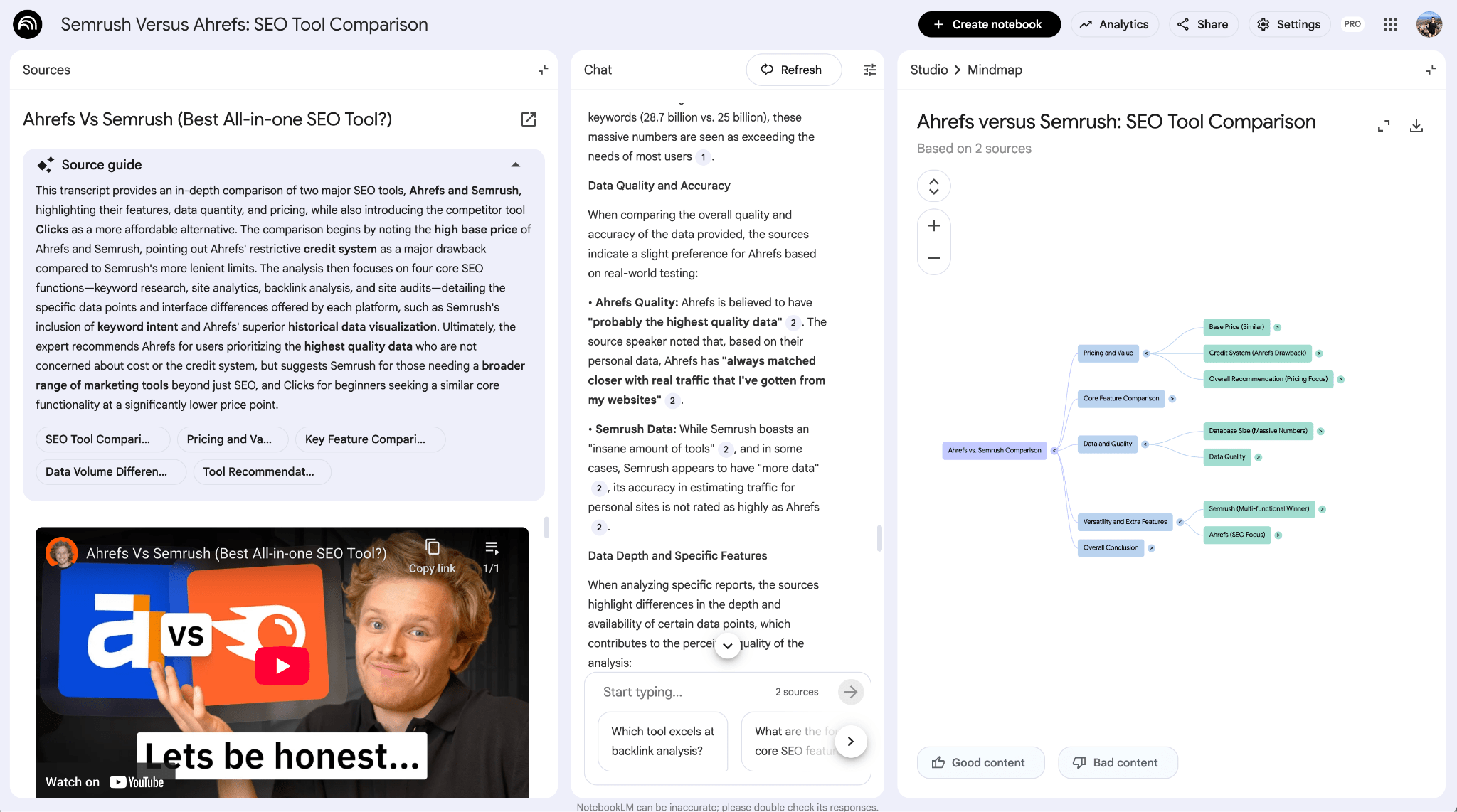
After setting up my filters, I immediately found two reviews pitting Ahrefs against Semrush.
The first came from “Marketing Island”, published back in May 2024. To date, it’s been viewed 10.2K times.

The second was from “Jaume Ros”, published back in August 2024 and viewed 3.4K times.

When you run them through NotebookLM, it becomes clear one recommends Semrush, and the other Ahrefs.
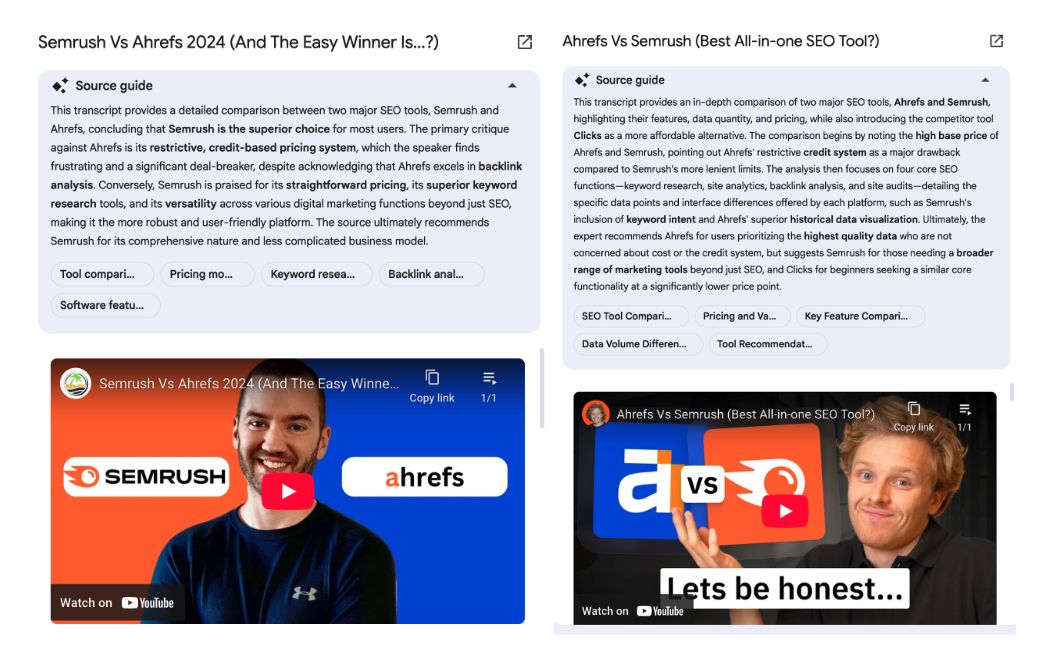
But in both cases, the creators review Ahrefs negatively due to our old “credits” based payment system, and the fact that we lack a broader range of marketing tools.
Our platform and pricing has changed a lot since these videos were created.
We’ve done away with credits, and added much more versatile marketing features like Brand Radar for AI monitoring, Social Media Manager for scheduling social posts, and Web Analytics—our GA4 alternative for analyzing all-site traffic.
One action we might take here is to reach out to these creators, update them on Ahrefs’ product developments, and ask if they’d be interested in filming new reviews.
This way we can improve the accuracy of the information surrounding our brand, and hopefully encourage more conversions.
Sponsored content often represents a big chunk of marketing investment.
Tracking your sponsored mentions helps you confirm whether content went live and measure which partnerships drove the best engagement.
Specifically, you can:
- Check deliverables: Confirm creators actually published the content they were paid for, and follow up on any missing or delayed content
- Assess the quality of the mention: Evaluate how authentically and prominently they featured your brand—did they mention you in the title and thumbnail or just once at the 8-minute mark in a 20-minute video?
- Track longevity: See if sponsored videos continue driving mentions over time or fade quickly. For example, if a video still generates mentions six months down the line, that creator delivered lasting value and is worth working with again
- Competitive intelligence: Track which creators your competitors are sponsoring, then learn from their strategy. Does it seem to be working? Could you go after similar influencers? Or differentiate your brand with distinct niche influencers?
How to analyze the YouTube mentions you sponsor
Once you’ve secured sponsorships, use Brand Radar to monitor them and make sure your budget is going to good use.
Remember all of the “does not contain” parameters you set up earlier (to filter out sponsored mentions)?
Switch them over to “contains”.
Make sure you’ve accounted for all the phrases or links you’ve asked your sponsors to include in their descriptions.
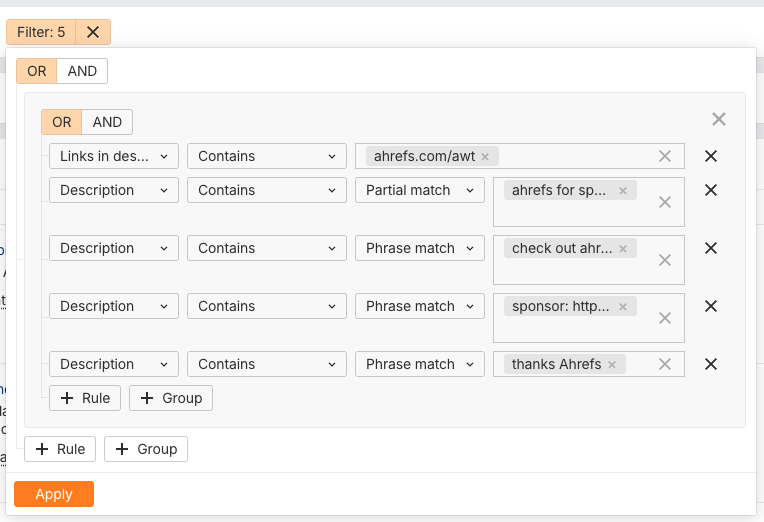
This will help you keep track on output, assess the relevance of your sponsored mentions, and compare the engagement generated by different partners.
You can also study how the partners of your competitors highlight their sponsor relationships (e.g. semrush encourages creators to promote their free trial).
Then use those findings to build out a query, so you can track rival sponsorships.
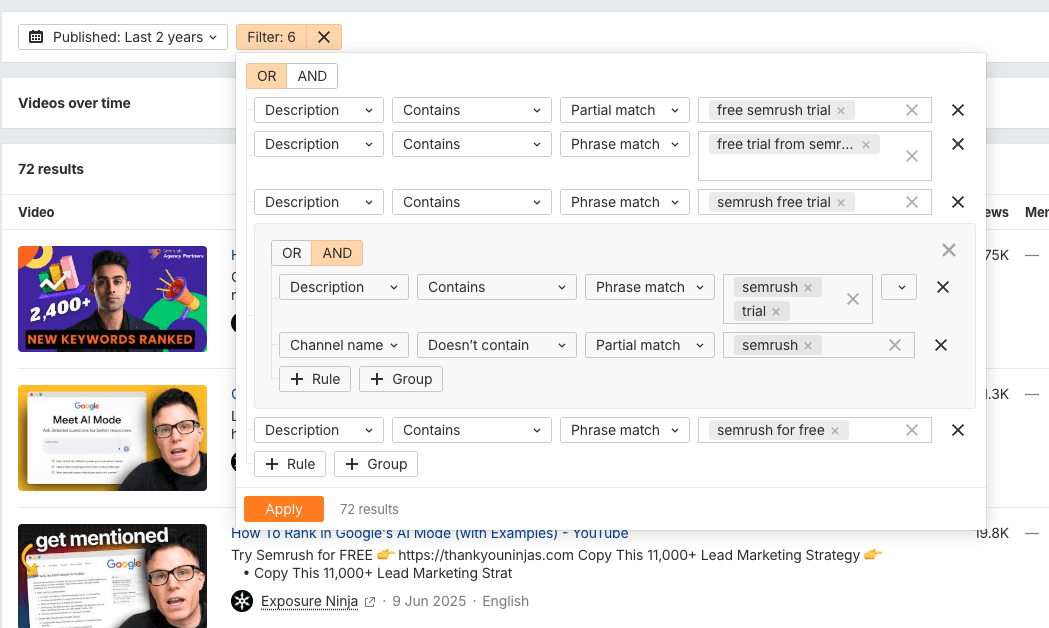
This kind of setup will help you find your competitors’ top creators and swoop in with better offers, or spot niches they’re ignoring, then own those spaces before they catch on.
YouTube is the 2nd most-cited source by LLMs—so video mentions directly influence how AI assistants position your brand.
Here’s what you gain from monitoring AI-cited content:
- Spot AI-driving mentions: See which video mentions lead to AI citations. For example, if a tutorial from “MarketingPro” generated 180 ChatGPT citations while your other sponsored video landed <20, prioritize “MarketingPro” for your next campaign—or replicate their tutorial format in your owned content
- Understand AI preferences: Learn which topics, formats, or creators AI favors most. Say AI cites 10-minute tutorial videos 5x more than 2-minute product demos, then you need to shift your video strategy to prioritize longer, educational formats
- Find the best AI partners: Target creators whose content is frequently cited in AI. For instance, if “TechReviewer101” appears in 70% of relevant AI responses, add them to your top-tier sponsorship list and consider allocating more budget to that partnership
- Create AI-led video content: Produce more of the video types AI references. For example, if AI consistently cites “How to do X with [Your Tool]” videos, script and produce five tutorial videos with that exact title format
- Measure dual impact: Track how YouTube presence boosts AI visibility. You can do this by monitoring your total AI citations post-sponsorship. If visibility jumps from 200 to 500 mentions, for example, then your partner is worth working with again
How to see whether your YouTube mentions drive up AI mentions
Whenever you find a mention of your brand in YouTube, drop the video URL into Brand Radar.
This will show you which of your YouTube mentions are also responsible for AI visibility across seven different AI assistants.
For instance, while analyzing how Ahrefs appears in recent “best tool” videos, I spotted this LearnWire mention:
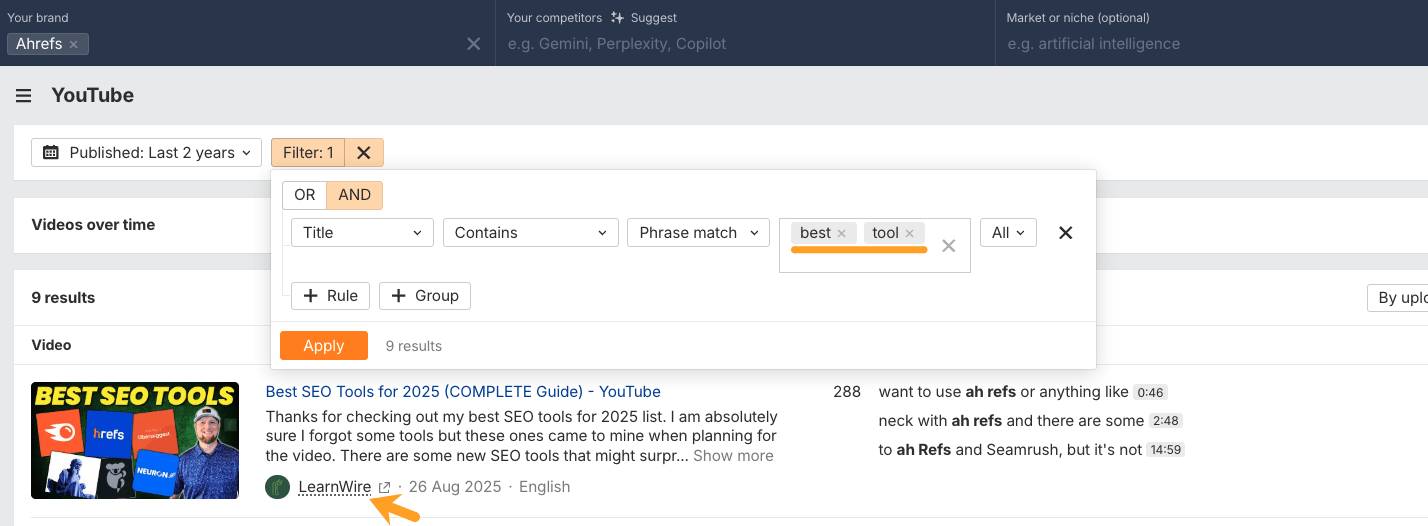
I took the URL over to the Brand Radar dashboard, and dropped it into the “URL > contains” filter:

As it happens, that one video triggered 254 mentions of Ahrefs in AI Overviews and AI Mode.
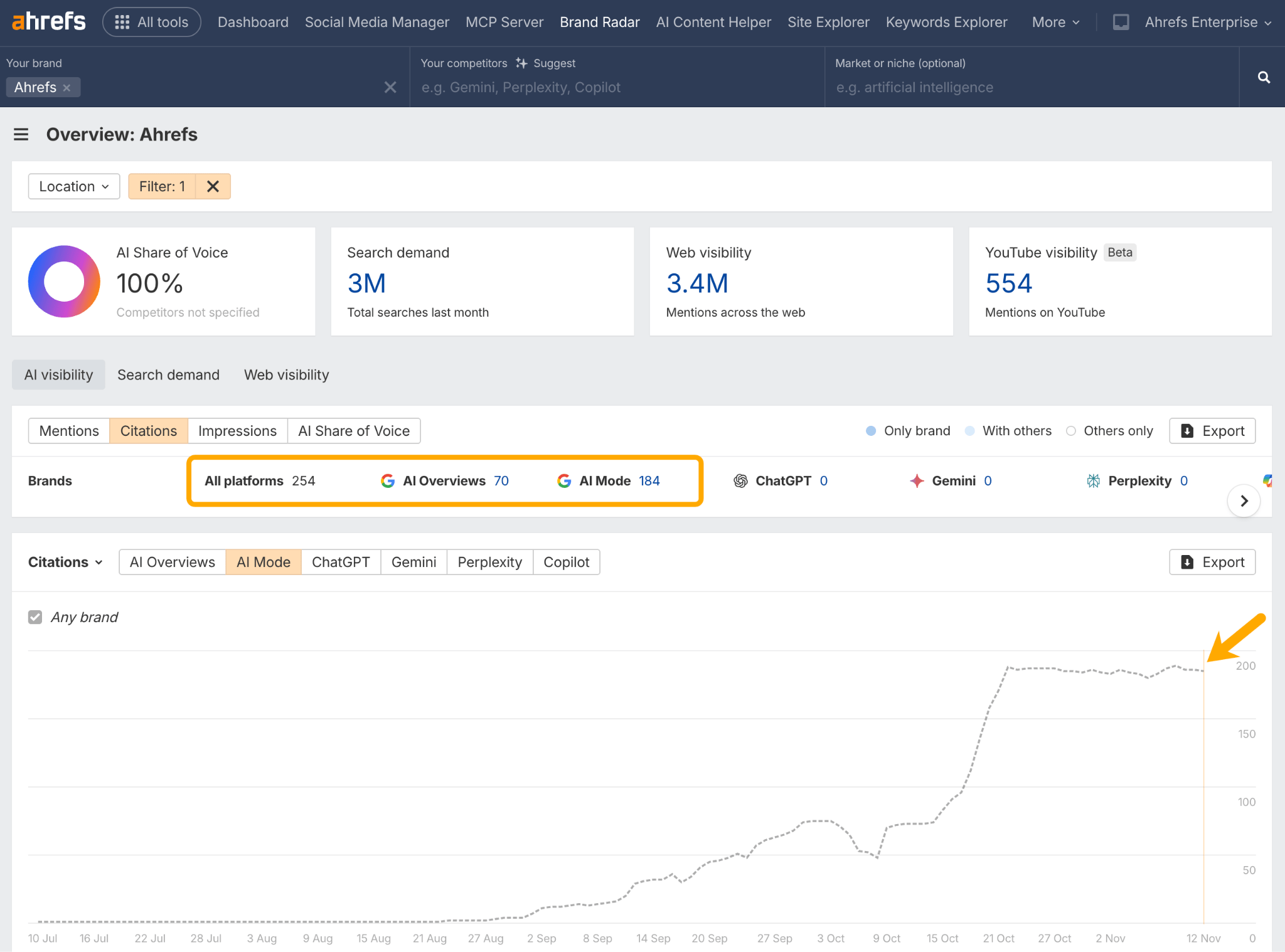
You can scale this analysis to find out which topics, formats, and creators AI cites most often—then run the same check on competitor mentions.
Then it’s just a case of producing and sponsoring more of that content.
Wrapping up
Your brand is being discussed on YouTube whether you’re watching or not.
Monitoring your video mentions will help you work out how creators position you, spot partnership opportunities, and connect your YouTube presence to AI visibility.
Start with monthly brand monitoring in Ahrefs Brand Radar to see where you stand.
